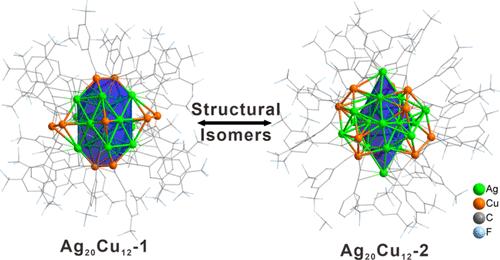双金属 Ag20Cu12 纳米团簇的结构异构性
IF 14.4
1区 化学
Q1 CHEMISTRY, MULTIDISCIPLINARY
引用次数: 0
摘要
原子精确金属纳米团簇的结构异构体在研究纳米结构材料的结构-性能关系时备受青睐。然而,由于合成和结构表征方面的挑战,这些异构体极为罕见,尤其是合金异构体。在此,我们首次可控地合成了一对双金属异构体银铜纳米团簇,并对其进行了结构表征。这两种异构体具有相同的分子式 Ag20Cu12(C≡CR)24(表示为 Ag20Cu12-1 和 Ag20Cu12-2;HC≡CR 是 3,5-双(三氟甲基)苯乙炔)。单晶 X 射线衍射数据分析显示,Ag20Cu12-1 具有一个 Ag17Cu4 内核,由两个相互渗透的空心 Ag11Cu2 结构组成。该核心由四种不同类型的表面图案稳定:八个 -C≡CR、一个 Cu(C≡CR)2、一个 Ag3Cu3(C≡CR)6 和两个 Cu2(C≡CR)4 单元。Ag20Cu12-2 具有一个二四面体 Ag14 核,由三个 Ag2Cu4(C≡CR)8 单元稳定。有趣的是,Ag20Cu12-2 在溶液状态下会自发转变为 Ag20Cu12-1。密度泛函理论计算解释了 Ag20Cu12-1 的电子和光学特性,并证实与 Ag20Cu12-2 相比,Ag20Cu12-1 具有更高的相对稳定性。本研究中介绍的合金纳米团簇的可控合成和结构异构将激励和拓宽对纳米级异构的研究。本文章由计算机程序翻译,如有差异,请以英文原文为准。

Structural Isomerism in Bimetallic Ag20Cu12 Nanoclusters
Structural isomers of atomically precise metal nanoclusters are highly sought after for investigating structure–property relationships in nanostructured materials. However, they are extremely rare, particularly those of alloys, primarily due to the challenges in their synthesis and structural characterization. Herein, for the first time, a pair of bimetallic isomeric AgCu nanoclusters has been controllably synthesized and structurally characterized. These two isomers share an identical molecular formula, Ag20Cu12(C≡CR)24 (denoted as Ag20Cu12-1 and Ag20Cu12-2; HC≡CR is 3,5-bis(trifluoromethyl)phenylacetylene). Single-crystal X-ray diffraction data analysis revealed that Ag20Cu12-1 possesses an Ag17Cu4 core composed of two interpenetrating hollow Ag11Cu2 structures. This core is stabilized by four different types of surface motifs: eight –C≡CR, one Cu(C≡CR)2, one Ag3Cu3(C≡CR)6, and two Cu2(C≡CR)4 units. Ag20Cu12-2 features a bitetrahedron Ag14 core, which is stabilized by three Ag2Cu4(C≡CR)8 units. Interestingly, Ag20Cu12-2 undergoes spontaneous transformation to Ag20Cu12-1 in the solution-state. Density functional theory calculations explain the electronic and optical properties and confirm the higher relative stability of Ag20Cu12-1 compared to Ag20Cu12-2. The controlled synthesis and structural isomerism of alloy nanoclusters presented in this work will stimulate and broaden research on nanoscale isomerism.
求助全文
通过发布文献求助,成功后即可免费获取论文全文。
去求助
来源期刊
CiteScore
24.40
自引率
6.00%
发文量
2398
审稿时长
1.6 months
期刊介绍:
The flagship journal of the American Chemical Society, known as the Journal of the American Chemical Society (JACS), has been a prestigious publication since its establishment in 1879. It holds a preeminent position in the field of chemistry and related interdisciplinary sciences. JACS is committed to disseminating cutting-edge research papers, covering a wide range of topics, and encompasses approximately 19,000 pages of Articles, Communications, and Perspectives annually. With a weekly publication frequency, JACS plays a vital role in advancing the field of chemistry by providing essential research.

 求助内容:
求助内容: 应助结果提醒方式:
应助结果提醒方式:


